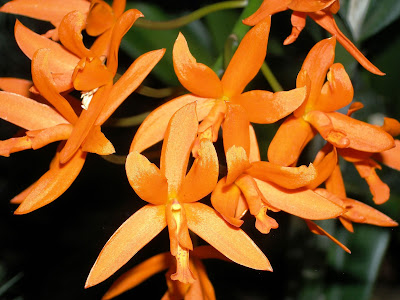Laelia cinnabarina is native to Brazil. It is found in the states of Minas Gerias, Sao Paulo and Rio de Janeiro between the elevations of 800 to 1500 meters above sea level in the foothills.
Laelia cinnabarina also called as The Cinnabar Laelia, Amalia cinnabarina, Amalias cinnabarina, Bletia cinnabarina, Bletia cinnabarina var sellowii, Bletia cinnamomea, Cattleya cinnabarina, Cattleya cinnabarina, Hoffmannseggella cinnabarina, Laelia cinnabarina var. sellowii, Laelia cinnamomea, Sophronitis cinnabarina, is a species of the genus Laelia. This species was described by James Bateman in 1847.
IDENTIFY LAELIA CINNABARINA ORCHID PLANT
Laelia cinnabarina is native to Brazil. It is found in the states of Minas Gerias, Sao Paulo and Rio de Janeiro between the elevations of 800 to 1500 meters above sea level in the foothills.
It is a small to medium sized, warm to cool growing lithophyte with cylindrical to oboclaviform, swollen at the base, up to 45 cm tall pseudobulbs enveloped by white, striated sheaths and carrying 1 or rarely 2, linear-oblong, erect or spreading, tinged purple leaves.
The Cinnabar Laelia blooms in the late winter and spring in cultivation on an erect, slender, to 60 cm long, racemose, 5 to 15 flowered inflorescence with a flattened basal sheath and carrying long-lasting, color variable flowers . The open, star-shaped flowers with narrow petals and sepals are 6.25 cm in diameter. The color varies from orange-yellow to bright orange.
LAELIA CINNABARINA ORCHID PLANT CARE AND CULTURE
Cultural information should only be used as a guide, and should be to be adapted to suit you. Your physical location; where you grow your plants, how much time you have to devote to their care, and many other factors, will need to be taken into account. Only then can you decide on the cultural methods that best suit you and your plants.
Light:
Laelia cinnabarina like good light (30000-40000 lux) with about 30-50% shade in summer but no direct sun. They require high light intensity during their dormant period in winter. They like direct morning sun but avoid afternoon light and deep shade.
Temperature:
The Cinnabar Laelia come from environments that have a normal temperature range of 16°C to 24°C with winter temperatures of about 12°C and rarely experience temperatures below 8°C.
Humidity:
This species need good air movement year round. They require moderate to high humidity (50-70%) in summer but low humidity in winter.
Substrate, growing media and repotting:
Laelia cinnabarina are usually grown in pots. Some growers recommend placing pieces of sandstone in the potting mix if root growth is a problem. Always use the smallest pot possible as they dry faster and large pots increase the risk of root rot.
This species don’t like being disturbed, when they outgrow the pot some growers simply place the plant and its pot into a slightly larger pot (over pot) allowing the roots to fill the space between the two pots. Repotting may be necessary however when the bark becomes decomposed.
Watering:
In their native environment this orchid receive daily rain in summer and so should receive regular watering during the warmer summer and autumn months, preferably daily in hot weather. Plants on slabs should be watered daily in warm weather. This species experience a 2-3 months dry season.
Fertilizer:
Liquid fertilizers should be applied regularly during the growing season but not in winter. Some growers recommend a low nitrogen but high phosphorus fertilizer in late summer and autumn. Liquid seaweed fertilizer can also be applied.
Rest period:
Laelia cinnabarina have a short 2-3 months dry period. Water, fertilizer should be reduced or completely stopped during this period. Well-grown plants have a purple tint to the foliage when grown under ideal lighting.















COMMENTS